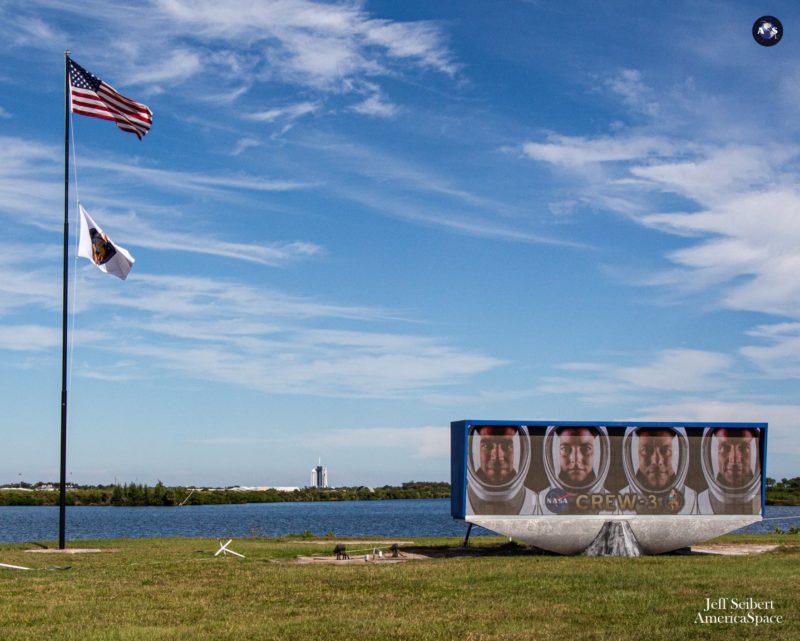
The International Space Station (ISS) must wait a little longer for the arrival of its next long-term team of astronauts, as NASA and SpaceX target the late evening of Saturday, 6 November, at the earliest, for liftoff of the Crew-3 mission. Launch of the brand-new Dragon Endurance atop a previously-flown Falcon 9 booster—originally set for early Halloween morning, then pushed back to the small hours of Wednesday—has been postponed a third time in response to a minor crew medical issue.
NASA astronauts Raja Chari, Tom Marshburn and Kayla Barron, plus Germany’s Matthias Maurer of the European Space Agency (ESA), will rocket away from historic Pad 39A at the Kennedy Space Center (KSC) in Florida, no sooner than 11:36 p.m. EDT Saturday. The four new arrivals are gearing up for a stay of more than five months aboard the sprawling orbital outpost.
As previously reported by AmericaSpace, the Crew-3 mission was originally set to fly early on Halloween morning, but was brought forward to 30 October in order to furnish a pair of back-to-back launch opportunities.
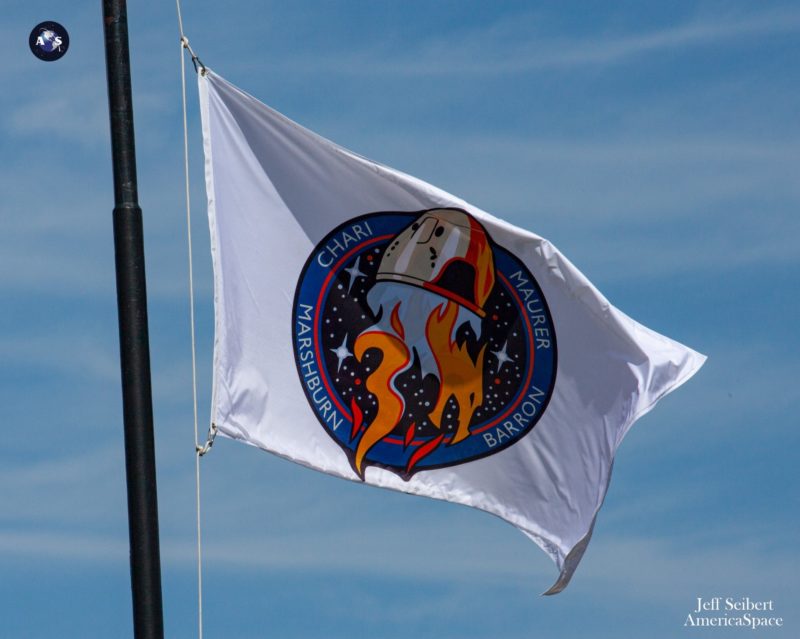
However, NASA later cited a need for “additional time for spacecraft processing” and T-0 returned to its original placeholder date of 2:21 a.m. EDT on the 31st. One key “open area” of work centered upon an issue which cropped up during Dragon Resilience’s three days in orbit with the Inspiration4 crew in September.
Following Resilience’s return to Earth, it became apparent that a tube inside the Crew Dragon’s urine storage tank had become disconnected. The result was that urine did not enter the tank as it ordinarily should, but went instead into the fan system. This had no impact on the comfort or activities of the Inspiration4 crew and did not manifest itself until it was uncovered during post-splashdown inspections.
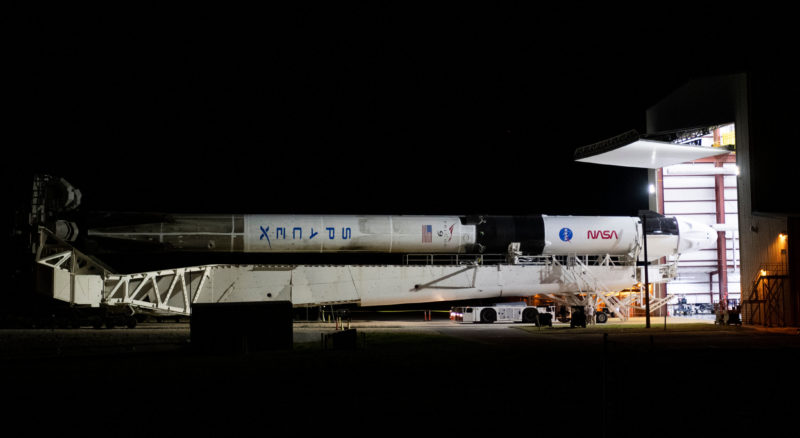
In the meantime, the on-orbit Crew-2 team—whose own Dragon Endeavour has been docked at the ISS since late April—were asked to inspect their own ship and noticed a similar problem, which revealed contamination underneath the spacecraft’s floor. In response to this issue, and with the potential for corrosion over the course of a long mission, the tubing to the urine storage tank aboard Dragon Endurance was modified with an all-welded structure.
According to NASA, additional enhancements in this third “new” Crew Dragon to carry astronauts include a software change to build in greater communications robustness against radiation effects during the docked phase at the ISS and more cleaning techniques to mitigate the occurrence of Foreign Object Debris (FOD).
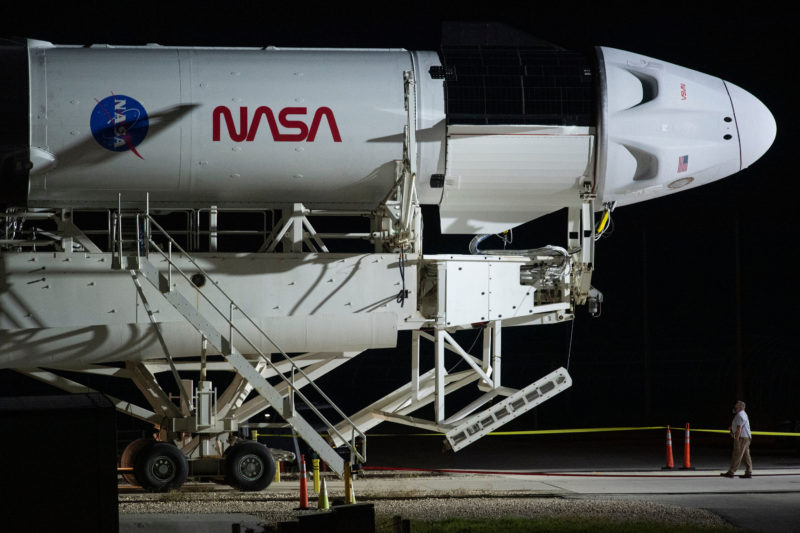
Other upgrades emphasize improved computer performance during Dragon Endurance’s re-entry phase and better procedures and mechanisms to limit hardware interference on the ISS “side” of the docking interface.
Aiming for a liftoff in the wee hours of Halloween morning, the 230-foot-tall (70-meter) Falcon 9 booster, with Endurance at its tip, was rolled out of the Horizontal Integration Facility (HIF) on the evening of 26 October and raised to the vertical on historic Pad 39A. It gave the astronauts a chance to participate in a gag photograph, which appeared to show Chari, Marshburn, Barron and Maurer lifting the great rocket by hand.
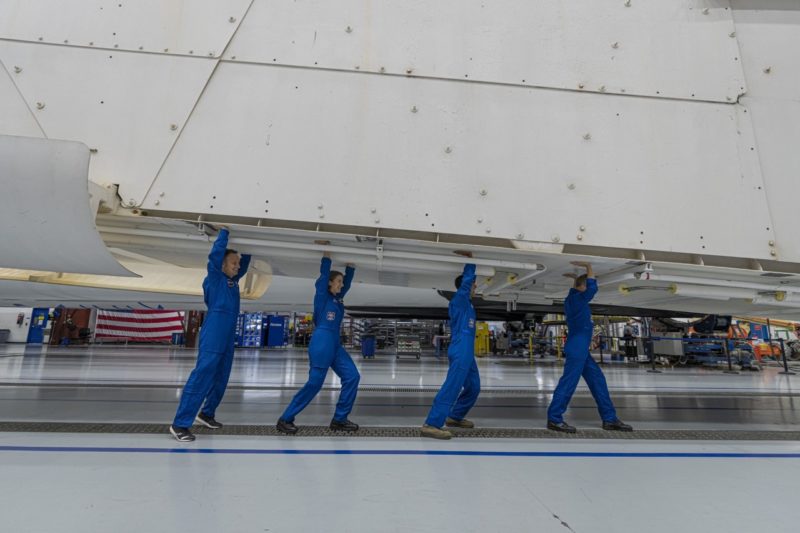
“It’s not everyday you get to drive your rocket to the @NASAKennedy launch pad and help stand it up…or at least have the @SpaceX photog let us pretend to do it,” quipped Chari.
Late the next day, the booster—whose B1067 core stage is making its second launch—underwent a customary Static Fire Test of the nine Merlin 1D+ engines. B1067, which also launched the CRS-22 Dragon cargo mission to the space station in early June, will become the 29th Falcon 9 core in four years to make a second flight.
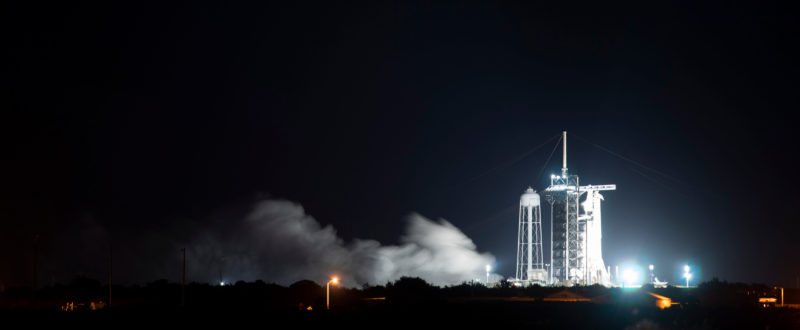
Following the Static Fire Test, Chari, Marshburn, Barron and Maurer completed a full dress rehearsal for their pre-launch tasks. Inside the Neil Armstrong Operations & Checkout Building, they donned their customized black-and-white SpaceX launch and entry suits and traveled in Tesla Model Xs out to the perimeter gate of Pad 39A.
Assisted by pad personnel, the four astronauts rode the elevator to the Crew Access Arm (CAA) and took their seats aboard Dragon Endurance. They underwent customary communications checks with ground controllers and the spacecraft’s hatch was closed. The rehearsal concluded at T-45 minutes, at which point—on the actual launch day—a Go/No-Go will be issued for fueling the booster with cryogenic liquid oxygen.
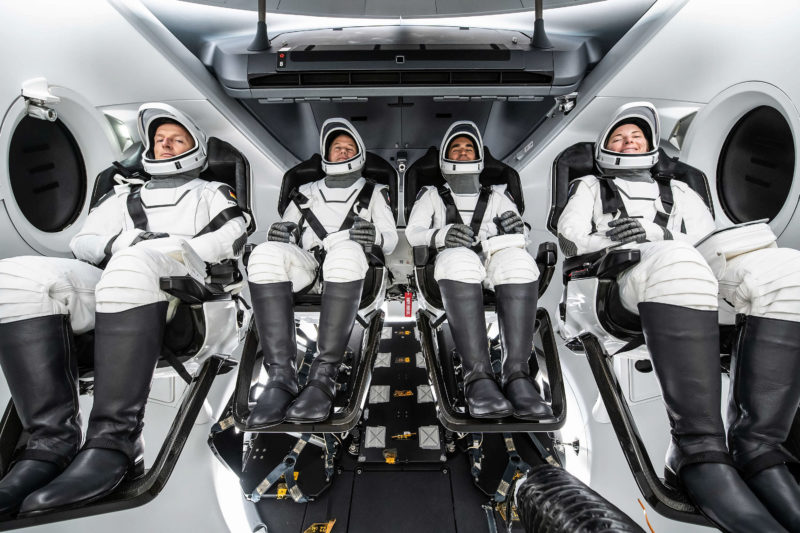
The dress rehearsal also provided a first glance at Crew-3’s launch day music playlist, shared by Chari, who joins only a handful of Americans—including Frank Borman and Neil Armstrong, commanders of the first mission to the Moon and the first landing on its surface—to lead the first flight of his astronaut career.
In a tweet, he explained that the dress rehearsal furnished him with a “great chance to check timing of launch day playlist”. That playlist includes Bon Jovi’s “Livin’ on a Prayer”, U2’s “Beautiful Day” and Queen’s “Don’t Stop Me Now”.
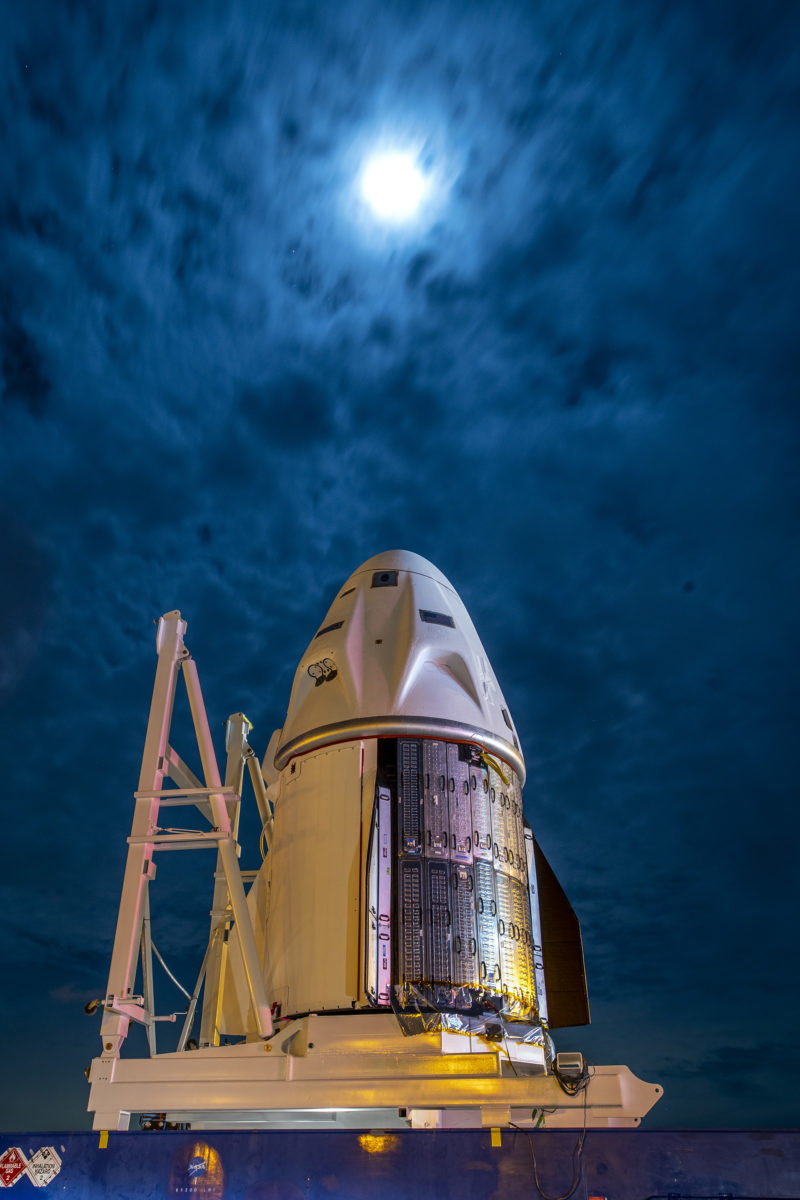
Unfortunately, another of the astronauts’ musical choices—TLC’s “No Scrubs”—has proven somewhat less apt. The first-ever U.S. crewed launch on Halloween did not come to pass, for the weather outlook did not look favorable.
Late on the 30th, NASA announced that the progress of a large, meandering storm system through the Ohio Valley and across the northeastern United States had made it necessary to postpone the launch until 1:10 a.m. EDT on 3 November.
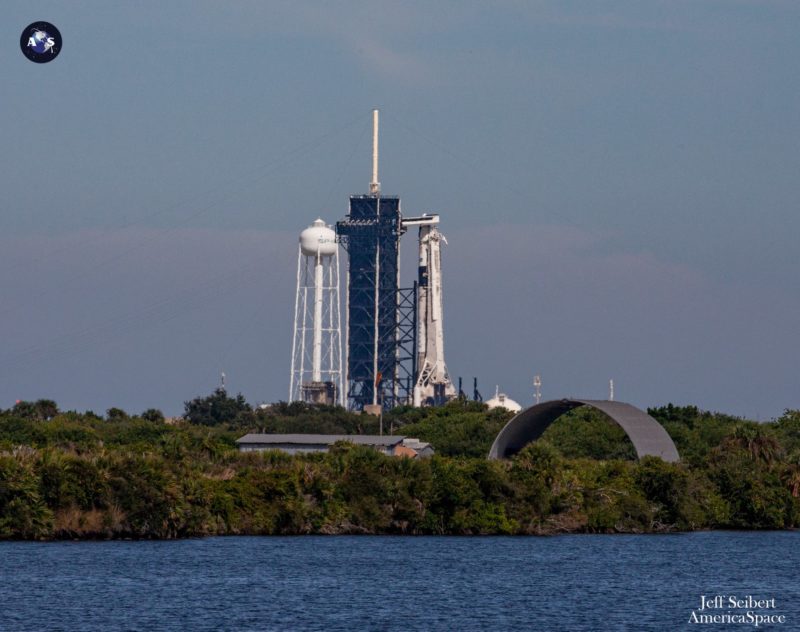
The weather situation was expected to significantly “elevate winds and waves in the Atlantic Ocean along the Crew Dragon flight path” in the event of a Halloween launch. Then on Monday, a further delay to the mission was announced, in response to “a minor medical issue involving one of its crew members”.
NASA cautioned that the issue was not a medical emergency, nor did it pertain to the ravages of the COVID-19 pandemic.
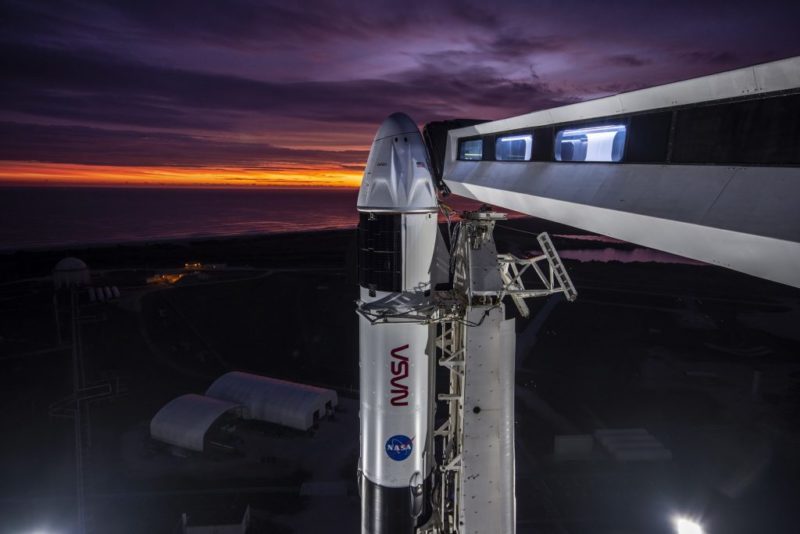
For his part, Maurer has spent a portion of his pre-flight quarantine doing his bit for the planet he is about to leave for six months.
“I’ve been relaxing during my quarantine by collecting rubbish on the beach,” he tweeted on Monday. “Sadly, this is not the only bag I filled. We really need to think about our environmental impact on Earth and in space. Clean oceans, clean space. It’s up to all of us.”
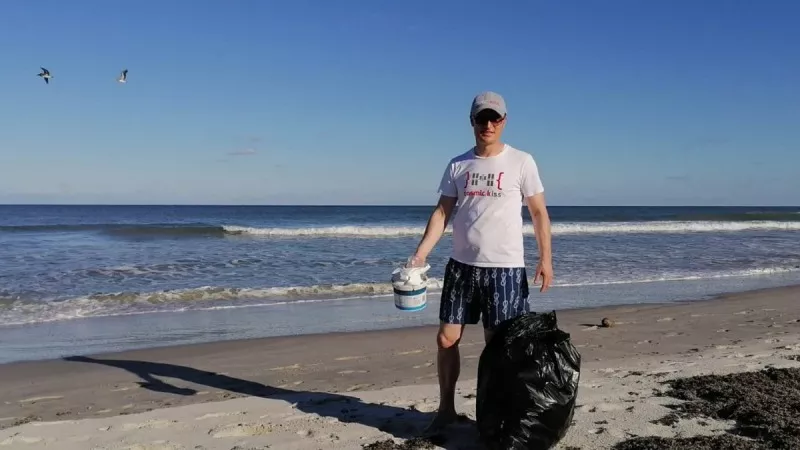
Currently targeted to fly no sooner than 11:36 p.m. EDT on Saturday, and with both the Falcon 9 booster and Dragon Endurance reportedly in excellent shape, this latest date hinges upon two principal factors: continued astronaut health and the weather.
According to the 45th Weather Squadron at Patrick Space Force Base, conditions for the 3rd were predicted to be 80-percent favorable, with a prevalence of “pleasant fall weather” over the Spaceport.
However, this was predicted to fall to 70-percent favorable on Thursday and only 50-50 for a launch on a day of “unsettled conditions” on Friday, as low-level flows looked set to bring a gradual increase of moisture, clouds and showers and an elevated potential for storms.
Assuming an on-time launch on Saturday night, it is expected that Dragon Endurance will follow a 22-hour rendezvous profile and dock at the forward-facing port of the station’s Harmony node at around 9:30 p.m. EDT on Sunday evening.
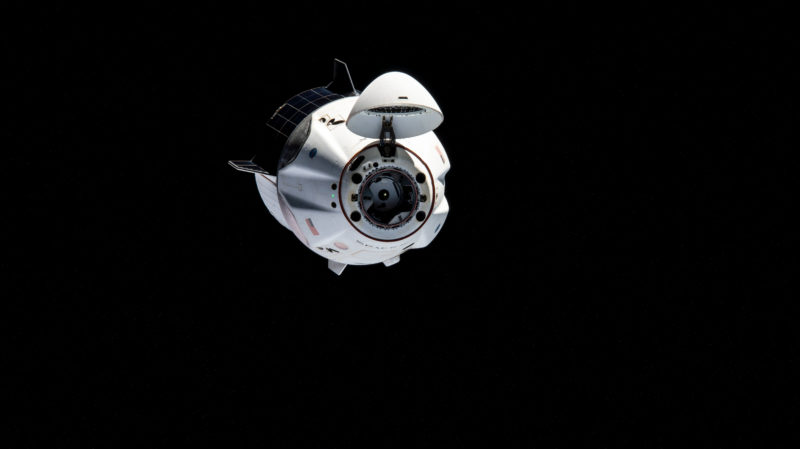
The new arrivals will be greeted by the incumbent Expedition 66 crew—Commander Thomas Pesquet of France, U.S. astronauts Mark Vande Hei, Shane Kimbrough and Megan McArthur, Russian cosmonauts Anton Shkaplerov and Pyotr Dubrov and Japan’s Aki Hoshide—to temporarily raise the ISS population to 11.
Current plans are for Kimbrough, McArthur, Hoshide and Pesquet to depart a few days later, returning to Earth aboard Dragon Endeavour to wrap up around 200 days in space.
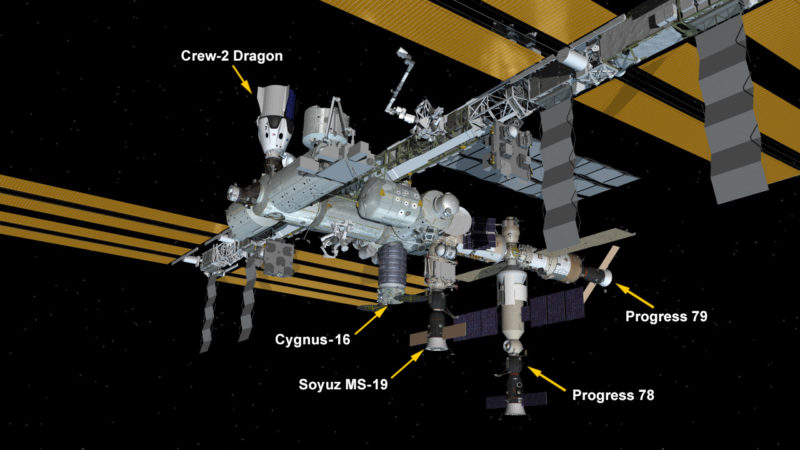
Expedition 66 will then continue as a crew of seven under Shkaplerov’s command. Current plans show a number of visiting vehicles, crewed and uncrewed, over the next few months. Two Russian Progress ships will launch in November and February, the first of which will deliver the 16-foot-long (5-meter) multi-port Prichal nodal module for the new Nauka lab.
And a pair of U.S. cargo missions—SpaceX’s CRS-24 Dragon in December and Northrop Grumman Corp.’s NG-17 Cygnus in February—are on the books to deliver science and a new modification kit for the next set of ISS Roll-Out Solar Arrays (iROSAs).
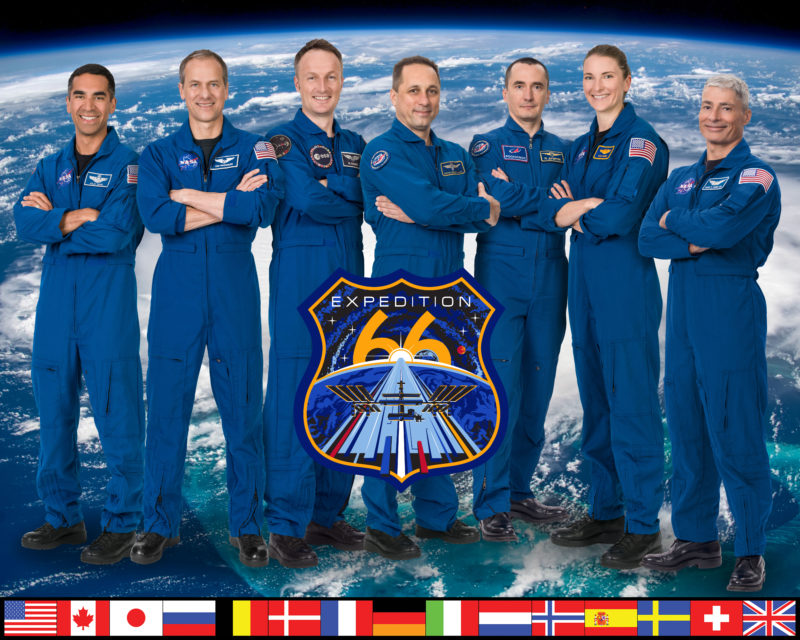
Three sessions of Extravehicular Activity (EVA) from the U.S. Operational Segment (USOS) are planned, including two iROSA-related spacewalks in February and another on 30 November. The latter will feature Marshburn and Barron and is tasked with the installation of an S-band communications antenna onto the station’s P-1 truss segment. Aged 61, Marshburn will surpass Russian cosmonaut Pavel Vinogradov to become the world’s oldest spacewalker.
Although the long-duration element of Expedition 66 will remain the same through next spring, the ISS is expected to welcome no fewer than two “visiting” crews. In December, Soyuz MS-20 will carry Russian cosmonaut Aleksandr Misurkin and Japanese Spaceflight Participants (SFPs) Yusaku Maezawa and Yozo Hirano on a 12-day flight to the station.
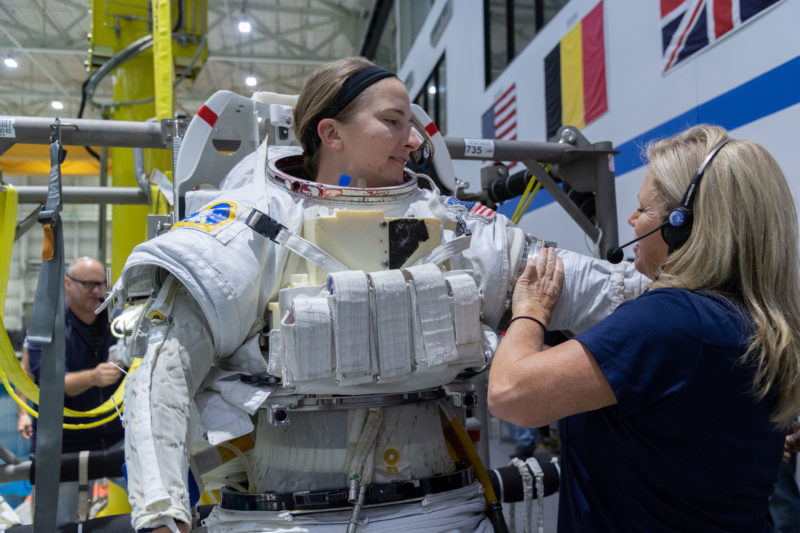
And in late February, Dragon Resilience will fly the ten-day Ax-1 commercial flight. Crewed by entrepreneurs Larry Connor, Mark Pathy and Eytan Stibbe, and commanded by former NASA astronaut and America’s premier spacewalker Mike Lopez-Alegria, it represents the first dedicated mission to the ISS by Houston-based AxiomSpace, Inc.
And with the exception of the underfloor contamination issue, Endeavour has behaved admirably on her second orbital mission. First launched on the Demo-2 mission on 30 May 2020, she saw Doug Hurley and Bob Behnken return U.S. astronauts to space aboard a U.S. spacecraft, atop a U.S. rocket, and from U.S. soil, for the first time since the end of the Space Shuttle Program.
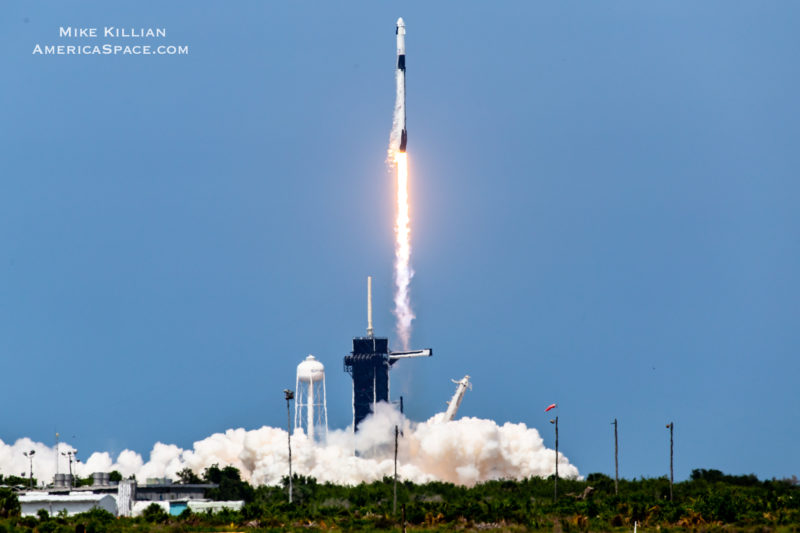
Hurley and Behnken logged 64 days in orbit, of which 62 were spent aboard the ISS alongside Expedition 63 Commander Chris Cassidy and his Russian crewmates Anatoli Ivanishin and Ivan Vagner.
Following Endeavour’s return to Earth on 2 August, marking the first U.S. astronaut crew to perform an oceanic splashdown since Apollo-Soyuz, she was put back into processing for the Crew-2 mission, which launched Kimbrough, McArthur, Hoshide and Pesquet to the station last 23 April.
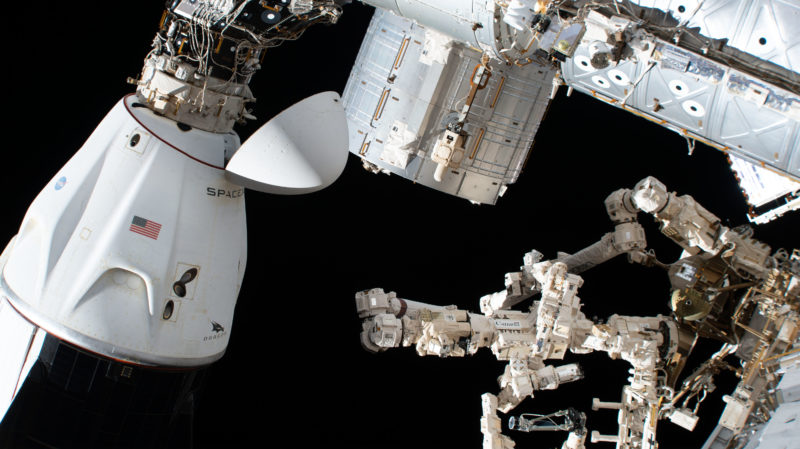
Early in October, Endeavour surpassed 167 days in orbit to set a new record for the longest single mission by a U.S. crew-carrying vehicle. That record has been twice broken in 2021, with her sister Resilience having eclipsed the almost-five-decade-long Skylab 4 record of 84 days back in February.
With her return to Earth later this month, Endeavour should come close to (or perhaps surpass) 200 days in space. Last week, the Crew-2 astronauts continued packing their ship for its departure, transferring emergency hardware, installing lockers and checking out their launch and entry suits.




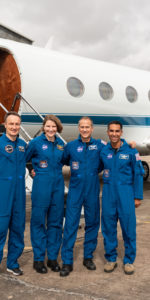
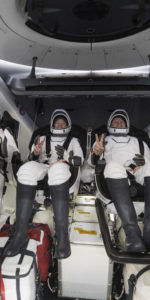
3 Comments
3 Pings & Trackbacks
Pingback:Crew-2 Returns Home, Wraps Up Longest Single Mission by U.S. Crewed Spacecraft – AmericaSpace
Pingback:Crew-3 Launches, Heads for Thursday Space Station Docking – AmericaSpace
Pingback:Crew-4 Aims for Pre-Dawn Wednesday Launch to Space Station - AmericaSpace